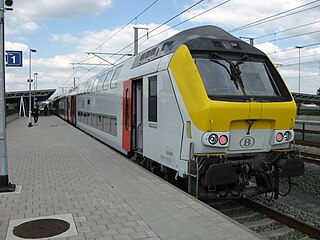
Transport in Belgium is facilitated with well-developed road, air, rail and water networks. The rail network has 2,950 km (1,830 mi) of electrified tracks. There are 118,414 km (73,579 mi) of roads, among which there are 1,747 km (1,086 mi) of motorways, 13,892 km (8,632 mi) of main roads and 102,775 km (63,861 mi) of other paved roads. There is also a well-developed urban rail network in Brussels, Antwerp, Ghent and Charleroi. The ports of Antwerp and Bruges-Zeebrugge are two of the biggest seaports in Europe. Brussels Airport is Belgium's biggest airport.
The National Railway Company of Belgium is the national railway company of Belgium. The company formally styles itself using the Dutch and French abbreviations NMBS/SNCB. The corporate logo designed in 1936 by Henry van de Velde consists of the linguistically neutral letter B in a horizontal oval.

Belgium has an extensive rail network. It is a member of the International Union of Railways (UIC). The UIC Country Code for Belgium is 88.

Charleroi-Central railway station is the main railway station serving Charleroi, Hainaut, Belgium. It is operated by the National Railway Company of Belgium (SNCB/NMBS). It was formerly called Charleroi-South railway station until December 2022.

The NMBS/SNCB Type 12 was a class of 4-4-2 steam locomotives built in 1938–1939 for the fast lightweight Ostend boat trains operated by the National Railway Company of Belgium.

The NMBS/SNCB Type 1 was a class of 4-6-2 steam locomotives built in 1935 and 1938 for working heavy express passenger trains operated by the National Railway Company of Belgium (NMBS/SNCB).

Antwerpen-Berchem railway station is a railway station in Berchem, in the south of Antwerp, Belgium. The station opened on 1 March 1865 and currently serves railway lines 25, 27, 27A and 59. The train services are operated by the National Railway Company of Belgium (NMBS/SNCB).

The Belgian State Railways was the original state-owned railway of Belgium. Established by an organic law of 1 May 1834, it began construction of its first line, between Brussels and Mechelen on 1 June 1834. This line, which was opened on 5 May 1835, was also the first steam-powered public railway in continental Europe.

The NMBS/SNCB Type 26 was a class of 2-10-0 steam locomotives built between 1945 and 1947. Originally commissioned as part of an order for 200 DRB Class 52 Kriegslokomotiven placed by the Deutsche Reichsbahn (DRG) with Belgian locomotive manufacturers in 1943, the 100 members of the Type 26 class were completed for the National Railway Company of Belgium (NMBS/SNCB) following the liberation of Belgium late in 1944.

The Belgian State Railways Type 10, later known as the NMBS/SNCB Type 10, was a class of 4-6-2 steam locomotives built between 1910 and 1914.

The Belgian State Railways Type 23, later known as the NMBS/SNCB Type 53, was a class of 0-8-0T steam locomotives built between 1904 and 1927.

Henri Borguet was Belgian entrepreneur who built in Belgium the first steam passenger railway in continental Europe, between Brussels and Mechelen.

The NMBS/SNCB Type 36 was a class of 2-10-0 Decapod steam locomotives built from 1909 to 1914 for heavy freight service in Belgium operated by the National Railway Company of Belgium.

The Belgian State Railways Type 1 was a class of 2-4-0 steam locomotives for passenger service, introduced in 1864.

The Belgian State Railways Type 25 was a class of 0-6-0 steam locomotives for freight service, introduced in 1884.

The Belgian State Railways Type 28 was a class of 0-6-0 steam locomotives for freight service, introduced in 1864.

The Belgian State Railways Type 51 was a class of 0-6-0T steam locomotives for shunting and local train service, introduced in 1866.

The Belgian State Railways Type 11 was a class of 0-6-0T steam locomotives for local passenger traffic, introduced in 1888. It gradually replaced the Type 5 in this role.
The Belgian State Railways Type 6 was a class of 2-6-0 steam locomotives for express passenger service on steep inclines, introduced in 1885.
The Usines Ragheno were a rolling stock manufacturer, building vehicles for railways and tramways. They are located in Mechelen, Belgium.






















